2007 News Archive
Quantum Cryptography: Unbreakable Code under the Laws of Physics
In the January-February 2007 issue of the Journal of Modern Optics, Professor Roman Sobolewski and his team at the University of Rochester, working with Moscow, Zurich/Delft, and Warsaw groups, announced a new receiver for superconducting single-photon detectors (SSPDs) that is especially useful for applications such as quantum cryptography and quantum communications. An SSPD is a nanostructured superconducting structure known for ultrafast, efficient detection of visible-to-infrared photons. In Professor Sobolewski's quantum cryptography system, photons with two separate polarizations (such as vertical and horizontal) can be simultaneously counted using two parallel channels. The receiver, designed for telecommunications wavelengths, is based on two fiber-coupled Niobium Nitrate (NbN) SSPDs operating at 4.2 Kelvin inside a liquid helium container. NbN is a metallic compound that operates as a superconductor when immersed in liquid helium at near absolute zero. Both the optical and electrical connections are outside the container at room temperature. Because the system operating time between helium refills is approximately two months, from a user's standpoint, the whole receiver is regarded as a "room-temperature-like" apparatus.
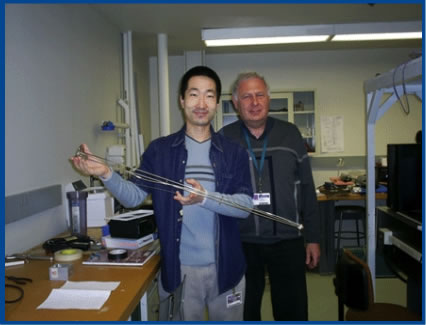
Above, Physics graduate student Dong Pan displays the new receiver for superconducting single photon detectors (SSPDs) that he built with Professor Sobolewski. A schematic of the device is shown below. The detectors are submerged in liquid helium, while the optical and electrical components are outside the container at room temperature.
In Professor Sobolewski's quantum cryptography system, photons with two separate polarizations (such as vertical and horizontal) can be simultaneously counted using two parallel channels. The receiver, designed for telecommunications wavelengths, is based on two fiber-coupled Niobium Nitrate (NbN) SSPDs operating at 4.2 Kelvin inside a liquid helium container. NbN is a metallic compound that operates as a superconductor when immersed in liquid helium at near absolute zero. Both the optical and electrical connections are outside the container at room temperature. Because the system operating time between helium refills is approximately two months, from a user's standpoint, the whole receiver is regarded as a "room-temperature-like" apparatus.
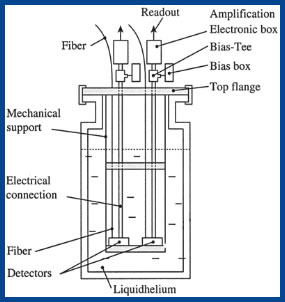
Optical quantum communications require photon counters with high speed, high sensitivity, high quantum efficiency, and short dead times along with precise timing characteristics and low dark counts. Quantum efficiency measures a device's sensitivity to the single-photon counting event and is a function of the photons' wavelengths. For example, it is a measure of the ratio of the number of electronic responses (commonly called "clicks") generated by the detector upon photon arrival per second to the number of photons incident on the detector per second. In a system with 100% quantum efficiency, every arriving/received photon is counted. Dead time refers to the time lag between the detection of one photon and the next. A dark count event is when the photon detector clicks but no photon was really received; basically, it is a false alarm. Of course, the dark count can also occur when a spurious photon arrives from, for example, another galaxy, and triggers the device, but that photon is not part of our communications system. These days, many extended commercial and military communications systems are based on optical fibers; thus, for practical quantum communications, detectors working at standard near-infrared telecommunications wavelengths of 1.3 micrometers and/or 1.55 micrometers are needed.
In their new system, Professor Soboleski's group obtained a telecommunications wavelength quantum efficiency of up to ~1% at 4.2 Kelvin. The quantum efficiency increased exponentially with the photon energy increase, reaching several percent level for visible-light photons. Dark count rates, measuring dark counts per second, were less than 10 Hz. As for dead time, Professor Sobolewski's SSPDs are capable of counting photons at a rate greater than 250 MHz with less than 40-picosecond timing jitter. The jitter is simply the uncertainty of the actual moment of photon arrival. The counting rate is how fast the detector can count the photons; it is the inverse of dead time.
Single-Photon Detectors: Background
Previously, only semiconducting materials were used to manufacture single-photon detectors. Silicon is typically used for visible light detectors, while indium gallium arsenide is suitable for infrared detectors. The semiconductor photon counting devices are called avalanche photodiodes and are currently commercially available.
An avalanche photodiode is made of a P-N junction just like any other diode; however, it is used in the reverse bias mode. A reverse bias mode is when the P junction of the diode is connected to a negative battery supply and the N junction is connected to the positive battery supply.
Current flows in only one direction through a P-N junction diode (forward mode operation). In reverse bias mode, a potential barrier exists across the P-N junction and there is almost no current flow through the device until a certain break off point.
Beyond this point, if the voltage is increased, the junction breaks off. Electrons are injected into the region very quickly accelerated under the influence of a large negative field. These electrons hit other electrons in their paths, creating a snowball effect. This is called an avalanche. Thus, one electron can avalanche into a very large signal.
In single-photon detectors, the diodes are biased at the avalanche knee, or the point beyond which an avalanche occurs. Whenever there is a single photon, it creates a single electron-hole pair, which is injected into the junction, pushing the device into the avalanche mode. The photo-generated electron is accelerated to create multiple electrons, which in turn produce a measurable signal, despite the fact that the initial input was very faint. Thus, instead of having to measure a single photo-generated electron, which is very difficult, a large signal is obtained that can be measured easily.
In visible light, single-photon Si-based devices work well and are being used in many systems. In infrared scenarios, however, the situation changes. This is because the energy band gap (energy difference between the valence band and the conduction band) of silicon is too large for infrared single photons; that is, their energy is not sufficient to photo-generate free electrons in Si.
With a view to resolving this issue, scientists try using indium gallium arsenide for P-N junctions. But so far, these devices have their own problems, mainly their response times are poor (they react slowly to incoming photons) and simultaneously, they exhibit very large dark count rates.
Superconductivity and Single-Photon Detectors
In 2001, Professor Sobolewski and his team published the first paper demonstrating that a nanostructured superconducting strip can be used as an optical single-photon counter. Superconductivity is a quantum mechanical phenomenon occurring in certain materials at extremely low temperatures, characterized by exactly zero electrical resistance for direct currents and bulk diamagnetism.
Bringing superconductivity into the picture helped reduce most of the background noise and thermal fluctuation (electrical disturbances inherent in materials) problems, resulting in devices with reduced dark counts and response times. Superconducting detectors also turned out to be efficient infrared-photon counters.
Because of the cold temperatures associated with superconductivity in the range of absolute zero (0 degrees Kelvin), a superconducting material is in a very calm state. Any change in this calm state has the effect of throwing a stone in a calm pond. Even the smallest stone being thrown produces noticeable ripples.
In superconductors, electrons are paired, and there is no resistance to direct current. The electron pairs are known as Cooper pairs.
The coupling energy of an electron pair is very small, approximately one-thousandth of the energy of a visible photon. When a light ray (photon) falls on it, the Cooper-pair coupling breaks, releasing two electrons, in the superconductivity language called quasiparticles.
A single optical photon can create approximately one thousand quasiparticles, locally producing a non-superconducting region called a hotspot.
(Below: Photon - breaks cooper pair, releases a phonon (quantum of heat) and two electrons. Hot spot - created when Cooper pairs break; a non-superconducting region)
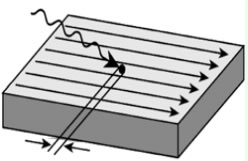
After the initial thermalization, the hotspot size grows as quasiparticles diffuse out of its center. At the same time, supercurrent (current of Cooper pairs) is expelled from the hotspot volume and is concentrated in the "sidewalks" between the hotspot and the edges of the film. The superconducting strip is biased just below the critical current. Thus, even a small increase in the current, concentrated in the sidewalks, exceeds the critical current, leading a non-superconducting barrier across the entire width of the device, and resulting in a temporary rise to a voltage signal.
Of course, inside the hotspot, its formation process (pair breaking) competes with the cooling process (recombination of quasiparticles back into Cooper pairs). In addition, electrons diffusing out of the hotspot lose their energy through electron-phonon scattering.
Thus, after a period of time the hotspot heals itself, the current of the stripe drops below the critical current, leading to the restoration of the superconducting path and zero voltage.
The restoration process is typically longer than the formation process, but it is still much faster than quenching an avalanche in semiconductor devices. Thus, SSPDs are very suitable for ultrafast, high repetition rate (clock) quantum communication applications.
(Below, left: Hot spot diffusion, superconductivity suppression. Below, right: Resistive region forms across the whole film.)
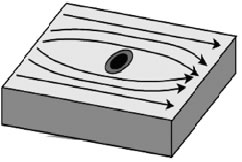
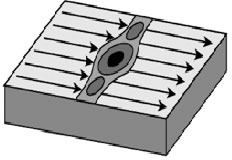
The Current SSPD Nanostructures
The stripes used for the detection of photons have to be very thin, only about 3-4 nanometers thick and 80-100 nanometers wide. In effect, nanowire geometry forces, in the presence of the hotspot, a resistive region to spread across the entire width of the stripe.
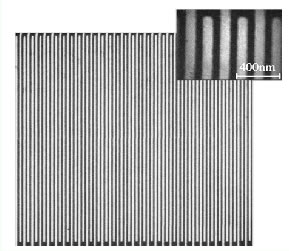
These devices are fabricated at the Moscow State Pedagogical University.(Reference: Gol'tsman et. al., IEEE Trans. Appl. Supercon., 13, 192, 2003.)
An SSPD meander consists of Niobium Nitrate (black portion) etched at particular portions (white part) to create a long winding line. Devices these days have extended meandered lines (dense structure with 50% fill factor), and the area is 10 microns by 10 microns, large enough to efficiently "catch" photons, as the probability of a photon hitting the lines increases with the detector area and in turn leads to higher quantum efficiencies, a necessary condition for practical quantum cryptography.
In addition to quantum communications and quantum key distribution, Professor Sobolewski's new SSPD receiver is also important for in other applications such as the testing of Very Large Scale Integration, or VLSI, chips. When a clock pulse passes through a chip, the transistors emit a very brief flash of infrared light. This flash can divulge quite a bit about the way a chip is working; for instance, whether or not the transistor is switching at the correct time. Other applications include NASA's interest in the detector for communications between Mars and Earth, infrared astronomy, and photon number resolving for quantum computing and quantum metrology.
-Excerpted from an article by Lois H. Gresh and ECE graduate student Anshul Popat.
